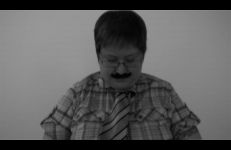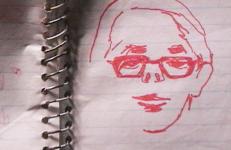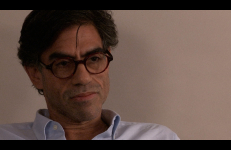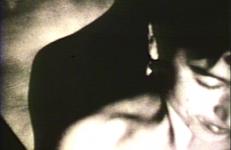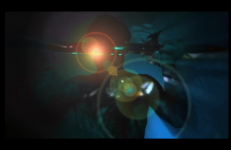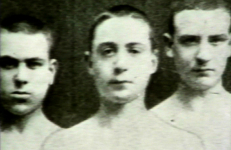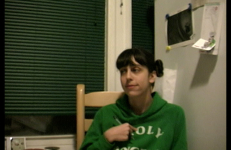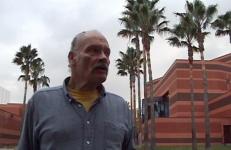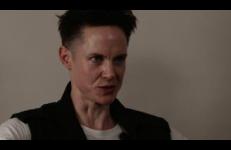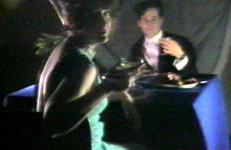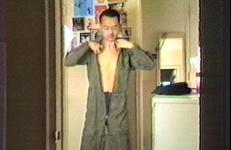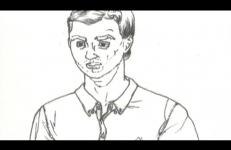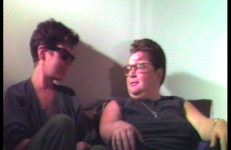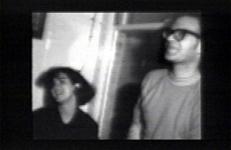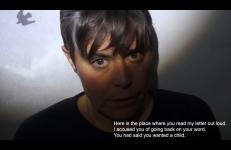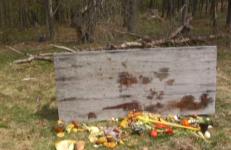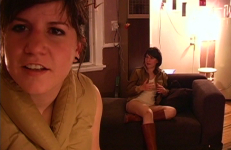After a long period in life identifying as a Butch Lesbian, Cuthand considers transitioning to male. This experience involved a six month period of his life during which he went by the name Sarain, which he would have been called had he been born a boy, and asking to be called by male pronouns. Complicated by mental health crises, Cuthand found themselves in a mental health group home for women, having to hide their gender dysphoria. After a considerable amount of thought and discussion, Cuthand changed his mind and decided to remain a Butch Lesbian.
LGBTQ
Through a stack of personal journals, this video reconstructs a biography of the South Dakota-born, New York City-enlightened artist James Wentzy. Tracing his days starting out as a struggling artist and later involved as an AIDS activist, the video provides an intimate portrait of a neglected hero. Wentzy reads from journals and shares old family snapshots and notebook sketches. “I hope I don’t die of sainthood,” Wentzy jokes in an entry from 1990—the pivotal time when he was becoming involved with ACT-UP and beginning to live healthier after the revelation of his HIV-positive status.
Gregg Bordowitz is a writer, AIDS activist, and film and videomaker. His work, including Fast Trip, Long Drop (1993) and Habit (2001), documents his personal experiences of testing positive and living with HIV within the context of a personal and global crisis. His writings are collected in The AIDS Crisis is Ridiculous and Other Writings:1986-2003.
A beautifully ambiguous study of the nude in light and movement, this short silent film focuses on the dimly lit bodies of two women shot from Child’s distinctly non-male perspective.
Blood percolates beneath the hot skin of sweat soaked men as they wrestle with primal urges that rip open hearts, tie the gut in knots and turn emotions inside out. With tortured mind the men must choose a future of "anger", or the warm "sweetness" that hides within their injured souls.
Produced for Britain’s Channel 4, Bright Eyes is an impressive and complex essay detailing the various factors that have colluded to misrepresent the true nature of the threat posed by AIDS. Exposing the relationship between the mass media, scientific systems of classification, and definitions of pathology, Marshall pinpoints the construction of sexual politics based on a reactionary morality. The video places the AIDS crisis in the context of the historical persecution of homosexuals and focuses on the efforts of gay activist groups to combat social and medical prejudice.
Los Angeles-based, Kaucyila Brooke (b.1952) makes what she describes as, "wall size photographic sequences in comic-strip format that consider lesbian relationships within American popular culture." Produced over the past five years, Brooke’s large-scale photo-text installations look at aspects of lesbian culture and alternative communities. Wry and often quite critical, they probe some of the ways lesbian relationships both challenge and reproduce the power relations and narratives of the wider culture.
A self-help speaker encourages self-reflection. Friends in Chicago hang out.
This title is also available on Chicago Sex Change: 2002-2008, A collection of Minax's early videos that together create a punk-documentary tapestry of young queer life in Chicago in the early 2000s.
A glittering, Las Vegas-inspired music video for John Sex’s song "Bump and Grind It". With an outrageous fountain hairdo (by stylist Danilo), Sex sings his catchy pop lyrics, “You gotta put your love behind it/Bump, bump, bump and grind it.” Featuring the Bodacious Ta-Tas and inter-cut with Vegas showgirl footage.
This title is also available on Tom Rubnitz Videoworks: Sexy, Wiggy, Desserty.
The Bus Stops Here is an experimental narrative about two sisters, Judith and Anna, plunged into depression by their struggle to gain control over their lives. Narrated by Judith’s counselor, The Bus Stops Here traps these women in a narrative in which their unmediated voices are rarely heard; instead, the viewer learns about them only through the interceding power structures of narrative, family, and psychiatric establishment.
This video diary visits two sites that exhibited my visual works this past year, culminating at the VOLTA ART SHOW in N.Y.C., where I sold some paintings and a photograph.
The underling theme of the diary deals with some bloating, scarring and beefcake exposure while on the road to an acting gig where I'm scheduled to play a BI-SEXUAL, paraplegic in heat.
There are some in depth scenes of me working out the romance/sex routines with a young and attractive, male co-star. The all-girl crew appears to be getting off on the whole thing and I don't blame them!
In conversation with David Getsy — an art historian focusing on queer and transgender methodologies in sculpture theory and performance history — Cassils discusses their monumental performance artworks and inspirations.
Taiwanese artist Shu Lea Cheang (b. 1954) tackles conceptions of racial assimilation in American culture, examining the political underbelly of everyday situations that affect the relationship between individuals and society.
Rubnitz’s short cooking clip showcases a chicken casserole recipe from the kitchen of Elaine Clearfield. All you need is chicken, rice, a packet of Lipton onion soup mix, a can of cream of mushroom condensed soup, and water!
This title is only available on Tom Rubnitz Videoworks: Sexy, Wiggy, Desserty.
Quoting Confucius, that “food and sex are human nature,” Chinese Characters builds a parallel between the Chinese legend about the search for the source of the Yellow River and contemporary Asian-Canadian gay men’s search for pleasure via their relationship to gay pornography. Advancing the positive value of pornography as a way to help fantasize and experience greater sexual pleasure and ingenuity, personal techniques are demonstrated and deployed in a High Noon dream of sexual adventure.
The Chocolate Factory is a suite of monologues in the voice of a fictionalized serial killer, one monologue for each victim. The camera, with an almost structuralist rigor, pans up and down simple line drawings of each of the seventeen victims. A Black Sabbath song, picked apart and extended, serves as punctuation and soundtrack. Reinke has described the video as, "My autobiography as Jeffrey Dahmer." But really, as the narrator says, "It's all about the victims."
An experiment in placing lesbian sexuality in its most common environment, daily life. Dougherty's initial intention was to represent lesbian sexuality with an objective camera by getting rid of all expressive aspects of camerawork — no close-ups, no zooms, no interesting angles or changes in subject-object dynamic, just straight-ahead shots. In this video, Dougherty studies whether sexuality can be separated from erotica, and whether all depictions of sexual acts are pornographic.
Shot primarily in Fisher-Price pixelvision, for the “murky look of memory," Coal Miner’s Granddaughter is a profoundly moving family portrait focusing on the youngest daughter Jane, as she leaves her Pennsylvania home and finds sexual independence in San Francisco. This semi-autobiographical narrative is remarkable for Dougherty’s unconventional approach: working with non-professional, plain-looking actors and improvised dialogue to recreate the life of the “average” family, and women who are “Plain Janes with big desires.”
Color Schemes was exhibited in its installation form (with a self-service washing machine) at the Whitney Museum in 1990. Using the washing machine as a metaphor for the great American “melting pot” of ethnicity, the video presents individuals from a variety of ethnic backgrounds “representing” their ethnicity — in one sense by being on camera, and also by acting out or speaking about ethnic divisions. Cheang plays with this “overdetermiNation” of ethnicity, creating a multi-layered discourse on racism and assimilation that condemns the former and refuses to condone the latter.
“The second in a planned trilogy of films about desire and domesticity that began with Strangely Ordinary This Devotion (2017), Come Coyote examines issues around queer reproduction, intimacy, and motherhood. Collaborators and partners Dani and Sheilah ReStack capture in fleeting, diaristic images the tender and terrifying feelings they have around ushering new life into the world, conveyed with both humor and a powerful immediacy."
— Projections at NYFF, 2019 catalogue
“The second in a planned trilogy of films about desire and domesticity that began with Strangely Ordinary This Devotion (2017), Come Coyote examines issues around queer reproduction, intimacy, and motherhood. Collaborators and partners Dani and Sheilah ReStack capture in fleeting, diaristic images the tender and terrifying feelings they have around ushering new life into the world, conveyed with both humor and a powerful immediacy."
— Projections at NYFF, 2019 catalogue
This humorous video begins with two women—one white, the other Asian—attempting to fit into a Japanese bathtub. The awkward fitting of bodies into a small space is just one of the allegorical scenarios dramatized in a pressing appeal for lesbian rights. In a game of hanafuda (flower cards), the terms of lesbian domesticity are cleverly played out according to such legalities as joint property, social security, and pensions.
Script/Performance Izumo Marou and Claire Maree, Superdyke Inc. Japan.
Song by Chu.
Community Action Center is a 69-minute sociosexual video by A.K. Burns and A.L. Steiner which incorporates the erotics of a community where the personal is not only political, but sexual. This project was heavily inspired by porn-romance-liberation films, such as works by Fred Halsted, Jack Smith, James Bidgood, Joe Gage and Wakefield Poole, which served as distinct portraits of the urban inhabitants, landscapes and the body politic of a particular time and place.
Community Action Center is a 69-minute sociosexual video by A.K. Burns and A.L. Steiner which incorporates the erotics of a community where the personal is not only political, but sexual. This project was heavily inspired by porn-romance-liberation films, such as works by Fred Halsted, Jack Smith, James Bidgood, Joe Gage and Wakefield Poole, which served as distinct portraits of the urban inhabitants, landscapes and the body politic of a particular time and place.
Compromise is Episode 1 of the video art trilogy, This is More Than Love I Feel Inside, in which Jillian Peña traces a queer relationship from inception to demise.




